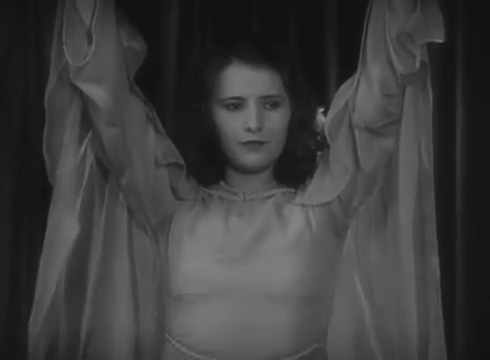|

Synopsis:
Grieving the death of her minister-father, a charismatic young woman (Barbara Stanwyck) joins forces with a charlatan (Sam Hardy) to pretend to be a miracle worker — but when she falls in love with a trusting blind man (David Manners), her values suddenly shift.
|
|
Genres, Themes, Actors, and Directors:
- Barbara Stanwyck Films
- Blindness
- Character Arc
- Con-Artists
- Frank Capra Films
- Missionaries and Revivalists
- Play Adaptation
- Romance
Review:
Frank Capra and Barbara Stanwyck collaborated on five features together, four of which are listed in Peary’s GFTFF: Ladies of Leisure (1930), The Bitter Tea of General Yen (1933), Meet John Doe (1941), and this adaptation of John Meehan and Robert Riskin’s play Bless You Sister (loosely based on the storied life of evangelist Aimee Semple McPherson). Unfortunately, The Miracle Woman fails to live up to its potential as a hard-hitting glimpse at the seedy underworld of fraudulent evangelism; instead, the majority of the screentime is taken up by an insipid romance barely worthy of discussion. Seemingly from a desire to establish and maintain the title character’s integrity, the film posits Stanwyck’s “Sister Florence” as a righteously scornful woman (we’re meant to sympathize with her position from the beginning) who quickly comes to see the error of her ways, and must then struggle against the evil machinations of sociopathic Hardy. While Stanwyck crafted countless memorable characterizations over the years, she’s not at her juiciest here; however, her nuanced performance remains as compelling as always, and is certainly worthy of the “Alternate Oscar” nomination Peary gives her. Meanwhile, Capra’s direction and Joseph Walker’s cinematography are superb throughout, presenting a highly atmospheric glimpse of a harsh historical era. (See the 1972 documentary Marjoe for a much more cynical take on the same topic.)
Note: I was surprised to learn that the disappointing Pre-Code screenplay for The Miracle Woman was written by Jo Swerling, responsible for several Hollywood gems — including Lifeboat (1944) and It’s a Wonderful Life (1946).
Redeeming Qualities and Moments:
- Barbara Stanwyck as Florence

- Effective direction by Capra


- Joseph Walker’s cinematography


Must See?
No, though it’s worth a look for Stanwyck’s performance. Listed as a film with Historical Importance in the back of Peary’s book.
Links:
|






One thought on “Miracle Woman, The (1931)”
Not a must.
None too subtle, ‘TMW’ basically comes off as one-note and obvious. Its presentational style also soon makes the film seem flat throughout. No allowance is made for nuance; the story is told in hard-nosed fashion so that we’ll get swept up in it.
Stanwyck begins the film with a speech that will bring to mind Richard Burton’s opening speech in ‘The Night of the Iguana’ – aimed at a hypocritical congregation. (~the kind of rebuke Walter Pidgeon also delivers in ‘How Green Was My Valley’.)
Religious phonies have been given more than a fair amount of coverage in film. But what’s on display here is similar to a much-superior film: Richard Brooks’ ‘Elmer Gantry’.